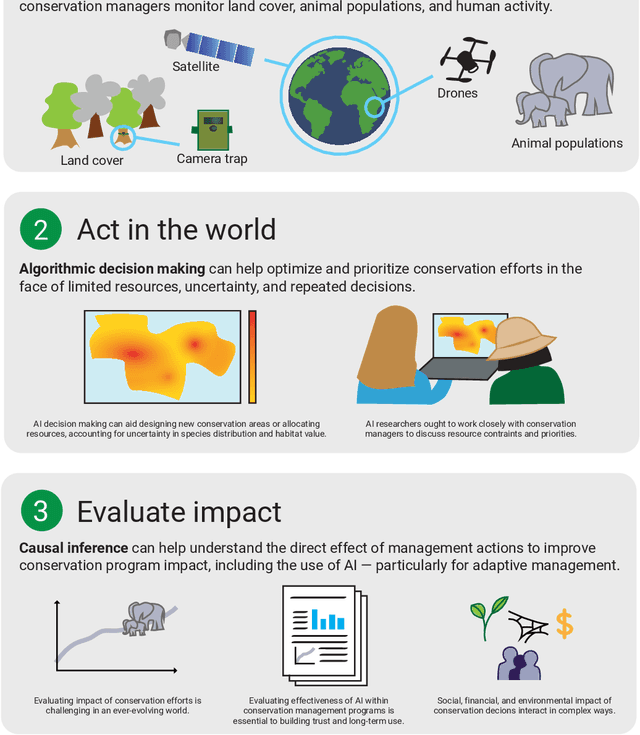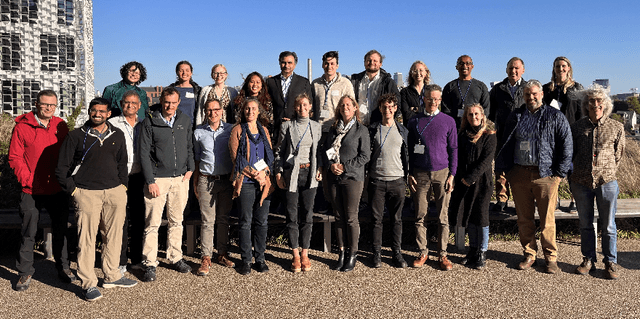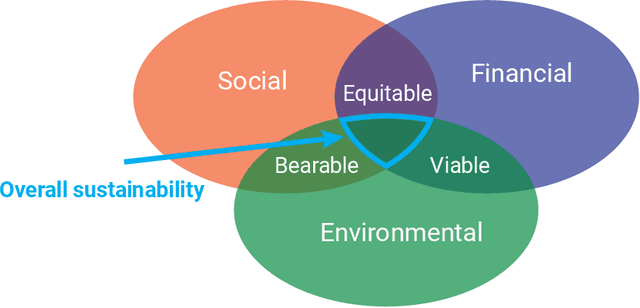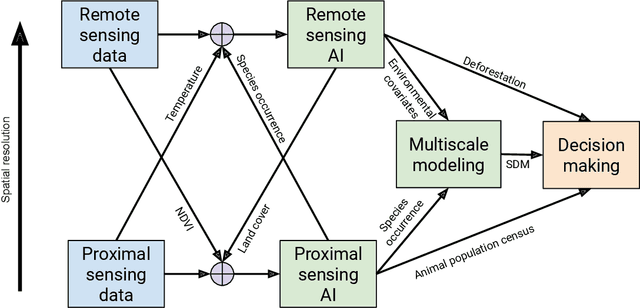Andrew Perrault
Cultivating Archipelago of Forests: Evolving Robust Decision Trees through Island Coevolution
Dec 18, 2024Abstract:Decision trees are widely used in machine learning due to their simplicity and interpretability, but they often lack robustness to adversarial attacks and data perturbations. The paper proposes a novel island-based coevolutionary algorithm (ICoEvoRDF) for constructing robust decision tree ensembles. The algorithm operates on multiple islands, each containing populations of decision trees and adversarial perturbations. The populations on each island evolve independently, with periodic migration of top-performing decision trees between islands. This approach fosters diversity and enhances the exploration of the solution space, leading to more robust and accurate decision tree ensembles. ICoEvoRDF utilizes a popular game theory concept of mixed Nash equilibrium for ensemble weighting, which further leads to improvement in results. ICoEvoRDF is evaluated on 20 benchmark datasets, demonstrating its superior performance compared to state-of-the-art methods in optimizing both adversarial accuracy and minimax regret. The flexibility of ICoEvoRDF allows for the integration of decision trees from various existing methods, providing a unified framework for combining diverse solutions. Our approach offers a promising direction for developing robust and interpretable machine learning models
Using RLHF to align speech enhancement approaches to mean-opinion quality scores
Oct 17, 2024Abstract:Objective speech quality measures are typically used to assess speech enhancement algorithms, but it has been shown that they are sub-optimal as learning objectives because they do not always align well with human subjective ratings. This misalignment often results in noticeable distortions and artifacts that cause speech enhancement to be ineffective. To address these issues, we propose a reinforcement learning from human feedback (RLHF) framework to fine-tune an existing speech enhancement approach by optimizing performance using a mean-opinion score (MOS)-based reward model. Our results show that the RLHF-finetuned model has the best performance across different benchmarks for both objective and MOS-based speech quality assessment metrics on the Voicebank+DEMAND dataset. Through ablation studies, we show that both policy gradient loss and supervised MSE loss are important for balanced optimization across the different metrics.
ARES: Alternating Reinforcement Learning and Supervised Fine-Tuning for Enhanced Multi-Modal Chain-of-Thought Reasoning Through Diverse AI Feedback
Jun 25, 2024Abstract:Large Multimodal Models (LMMs) excel at comprehending human instructions and demonstrate remarkable results across a broad spectrum of tasks. Reinforcement Learning from Human Feedback (RLHF) and AI Feedback (RLAIF) further refine LLMs by aligning them with specific preferences. These methods primarily use ranking-based feedback for entire generations. With advanced AI models (Teacher), such as GPT-4 and Claude 3 Opus, we can request various types of detailed feedback that are expensive for humans to provide. We propose a two-stage algorithm ARES that Alternates REinforcement Learning (RL) and Supervised Fine-Tuning (SFT). First, we request the Teacher to score how much each sentence contributes to solving the problem in a Chain-of-Thought (CoT). This sentence-level feedback allows us to consider individual valuable segments, providing more granular rewards for the RL procedure. Second, we ask the Teacher to correct the wrong reasoning after the RL stage. The RL procedure requires massive efforts for hyperparameter tuning and often generates errors like repetitive words and incomplete sentences. With the correction feedback, we stabilize the RL fine-tuned model through SFT. We conduct experiments on multi-model dataset ScienceQA and A-OKVQA to demonstrate the effectiveness of our proposal. ARES rationale reasoning achieves around 70% win rate against baseline models judged by GPT-4o. Additionally, we observe that the improved rationale reasoning leads to a 2.5% increase in inference answer accuracy on average for the multi-modal datasets.
Symmetric Reinforcement Learning Loss for Robust Learning on Diverse Tasks and Model Scales
May 29, 2024Abstract:Reinforcement learning (RL) training is inherently unstable due to factors such as moving targets and high gradient variance. Reinforcement Learning from Human Feedback (RLHF) and Reinforcement Learning from AI Feedback (RLAIF) can introduce additional difficulty. Differing preferences can complicate the alignment process, and prediction errors in a trained reward model can become more severe as the LLM generates unseen outputs. To enhance training robustness, RL has adopted techniques from supervised learning, such as ensembles and layer normalization. In this work, we improve the stability of RL training by adapting the reverse cross entropy (RCE) from supervised learning for noisy data to define a symmetric RL loss. We demonstrate performance improvements across various tasks and scales. We conduct experiments in discrete action tasks (Atari games) and continuous action space tasks (MuJoCo benchmark and Box2D) using Symmetric A2C (SA2C) and Symmetric PPO (SPPO), with and without added noise with especially notable performance in SPPO across different hyperparameters. Furthermore, we validate the benefits of the symmetric RL loss when using SPPO for large language models through improved performance in RLHF tasks, such as IMDB positive sentiment sentiment and TL;DR summarization tasks.
Reinforcement Learning for Fine-tuning Text-to-speech Diffusion Models
May 23, 2024Abstract:Recent advancements in generative models have sparked significant interest within the machine learning community. Particularly, diffusion models have demonstrated remarkable capabilities in synthesizing images and speech. Studies such as those by Lee et al. [19], Black et al. [4], Wang et al. [36], and Fan et al. [8] illustrate that Reinforcement Learning with Human Feedback (RLHF) can enhance diffusion models for image synthesis. However, due to architectural differences between these models and those employed in speech synthesis, it remains uncertain whether RLHF could similarly benefit speech synthesis models. In this paper, we explore the practical application of RLHF to diffusion-based text-to-speech synthesis, leveraging the mean opinion score (MOS) as predicted by UTokyo-SaruLab MOS prediction system [29] as a proxy loss. We introduce diffusion model loss-guided RL policy optimization (DLPO) and compare it against other RLHF approaches, employing the NISQA speech quality and naturalness assessment model [21] and human preference experiments for further evaluation. Our results show that RLHF can enhance diffusion-based text-to-speech synthesis models, and, moreover, DLPO can better improve diffusion models in generating natural and high quality speech audios.
The Distributional Reward Critic Architecture for Perturbed-Reward Reinforcement Learning
Jan 11, 2024Abstract:We study reinforcement learning in the presence of an unknown reward perturbation. Existing methodologies for this problem make strong assumptions including reward smoothness, known perturbations, and/or perturbations that do not modify the optimal policy. We study the case of unknown arbitrary perturbations that discretize and shuffle reward space, but have the property that the true reward belongs to the most frequently observed class after perturbation. This class of perturbations generalizes existing classes (and, in the limit, all continuous bounded perturbations) and defeats existing methods. We introduce an adaptive distributional reward critic and show theoretically that it can recover the true rewards under technical conditions. Under the targeted perturbation in discrete and continuous control tasks, we win/tie the highest return in 40/57 settings (compared to 16/57 for the best baseline). Even under the untargeted perturbation, we still win an edge over the baseline designed especially for that setting.
Coevolutionary Algorithm for Building Robust Decision Trees under Minimax Regret
Dec 14, 2023



Abstract:In recent years, there has been growing interest in developing robust machine learning (ML) models that can withstand adversarial attacks, including one of the most widely adopted, efficient, and interpretable ML algorithms-decision trees (DTs). This paper proposes a novel coevolutionary algorithm (CoEvoRDT) designed to create robust DTs capable of handling noisy high-dimensional data in adversarial contexts. Motivated by the limitations of traditional DT algorithms, we leverage adaptive coevolution to allow DTs to evolve and learn from interactions with perturbed input data. CoEvoRDT alternately evolves competing populations of DTs and perturbed features, enabling construction of DTs with desired properties. CoEvoRDT is easily adaptable to various target metrics, allowing the use of tailored robustness criteria such as minimax regret. Furthermore, CoEvoRDT has potential to improve the results of other state-of-the-art methods by incorporating their outcomes (DTs they produce) into the initial population and optimize them in the process of coevolution. Inspired by the game theory, CoEvoRDT utilizes mixed Nash equilibrium to enhance convergence. The method is tested on 20 popular datasets and shows superior performance compared to 4 state-of-the-art algorithms. It outperformed all competing methods on 13 datasets with adversarial accuracy metrics, and on all 20 considered datasets with minimax regret. Strong experimental results and flexibility in choosing the error measure make CoEvoRDT a promising approach for constructing robust DTs in real-world applications.
Reflections from the Workshop on AI-Assisted Decision Making for Conservation
Jul 17, 2023



Abstract:In this white paper, we synthesize key points made during presentations and discussions from the AI-Assisted Decision Making for Conservation workshop, hosted by the Center for Research on Computation and Society at Harvard University on October 20-21, 2022. We identify key open research questions in resource allocation, planning, and interventions for biodiversity conservation, highlighting conservation challenges that not only require AI solutions, but also require novel methodological advances. In addition to providing a summary of the workshop talks and discussions, we hope this document serves as a call-to-action to orient the expansion of algorithmic decision-making approaches to prioritize real-world conservation challenges, through collaborative efforts of ecologists, conservation decision-makers, and AI researchers.
Leaving the Nest: Going Beyond Local Loss Functions for Predict-Then-Optimize
May 26, 2023Abstract:Predict-then-Optimize is a framework for using machine learning to perform decision-making under uncertainty. The central research question it asks is, "How can the structure of a decision-making task be used to tailor ML models for that specific task?" To this end, recent work has proposed learning task-specific loss functions that capture this underlying structure. However, current approaches make restrictive assumptions about the form of these losses and their impact on ML model behavior. These assumptions both lead to approaches with high computational cost, and when they are violated in practice, poor performance. In this paper, we propose solutions to these issues, avoiding the aforementioned assumptions and utilizing the ML model's features to increase the sample efficiency of learning loss functions. We empirically show that our method achieves state-of-the-art results in four domains from the literature, often requiring an order of magnitude fewer samples than comparable methods from past work. Moreover, our approach outperforms the best existing method by nearly 200% when the localness assumption is broken.
Normality-Guided Distributional Reinforcement Learning for Continuous Control
Aug 28, 2022



Abstract:Learning a predictive model of the mean return, or value function, plays a critical role in many reinforcement learning algorithms. Distributional reinforcement learning (DRL) methods instead model the value distribution, which has been shown to improve performance in many settings. In this paper, we model the value distribution as approximately normal using the Markov Chain central limit theorem. We analytically compute quantile bars to provide a new DRL target that is informed by the decrease in standard deviation that occurs over the course of an episode. In addition, we suggest an exploration strategy based on how closely the learned value distribution resembles the target normal distribution to make the value function more accurate for better policy improvement. The approach we outline is compatible with many DRL structures. We use proximal policy optimization as a testbed and show that both the normality-guided target and exploration bonus produce performance improvements. We demonstrate our method outperforms DRL baselines on a number of continuous control tasks.
 Add to Chrome
Add to Chrome Add to Firefox
Add to Firefox Add to Edge
Add to Edge